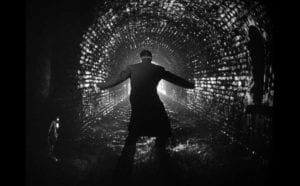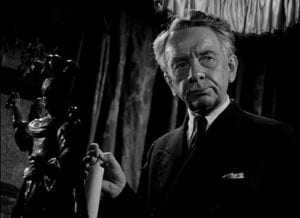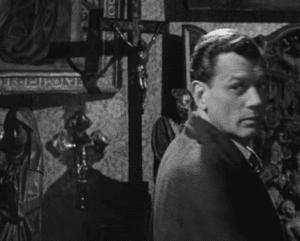Paul Dakin
London, United Kingdom
 |
| Film Forum: The Third Man |
Times of crisis may highlight the best and worst characteristics of people. Many of us yearn to be heroes and yet what is revealed under pressure may fall short of our ideal. Doctors share this human frailty. Is medical training and professionalism enough to overcome personal weakness, allowing our behavior to remain moral and ethical? Or can self-interest sweep aside high-minded values in the face of adversity? One of the greatest films of the twentieth century, The Third Man, explores these issues through the example of a doctor who compromises his professional principles.
In 1948, the novelist Graham Greene was asked to write the screenplay for a film in the immediate aftermath of the Second World War. Setting the story in Vienna, he discovered a shattered city that had been devastated by the bombing and bombardment of a Soviet attack that killed nearly 40,000 soldiers and countless civilians. He was shocked to find innumerable people living on the streets and in the ruins of crumbling buildings, survivors not only of the war, but also the appalling winter of 1946/47.
Poverty and disease were rife, and in order to survive, as Baron Kurtz, one of the film’s characters explains, “everyone” was involved in the black market. Like Berlin, Vienna was divided into four zones by the Allies, who rigidly controlled the movement of the city dwellers and the large numbers of refugees arriving from Eastern Europe. Greene, along with producer Alexander Korda, had served in military intelligence during the war. He found that some of his former colleagues, including the yet to be exposed double agent Kim Philby, were stationed in Vienna. Inquiring about illegal activities in the city, Greene was told two crucial facts that would form the basis of his plot—the black market trade in penicillin, and a network of underground sewers used by racketeers to move between zones.1
In our age of easy—perhaps too easy—access to antibiotics, the idea of illicit trading in penicillin seems odd. But although penicillin had been discovered in 1928, it was first used on a large scale in 1941, and remained largely restricted for the treatment of military personnel. Its existence was classified as a military secret, a fact that did not prevent US intelligence from exchanging penicillin for information with a Bulgarian doctor working in the Soviet sector.2
 |
| Dr. Winkel played by Erich Ponto. (YouTube) The Third Man, Dr. (W)inkel Yu Zhang. |
In such circumstances, the scarcity of penicillin made it “a highly sought commodity in a dangerous and dirty city full of potentially treatable infection.”3 In Greene’s screenplay, Harry Lime, played by Orson Welles, organized the theft of the antibiotic from an American military hospital. Lime’s gang diluted the drug and sold their version at a high price under the cover of his medical charity. Among Lime’s co-conspirators is Dr. Winkel, a pedantic dilettante, who despite being an atheist, collects religious artifacts. Although his role is never explained, Winkel benefits from a racket that sold tubes of diluted penicillin for £70 per tube (the equivalent of £2000 today).
The film begins as Holly Martins arrives in Vienna just in time to attend Lime’s funeral. Martins is puzzled about the coincidences surrounding his friend’s death, such as the convenient presence of Lime’s physician, Dr. Winkel, at his fatal road accident. Dr. Winkel had then signed the death certificate and arranged a hasty burial.
Martins visited Dr. Winkel at home to ask about Lime’s death. Dr. Winkel is carving a huge chicken, which contrasts with the ragged street dwellers picking through rubbish. Winkel’s maid shows Martins into a room crammed with antiques. Winkel’s evident prosperity is one issue prompting the view that “a moral reckoning must come in a critical study of the film.”4 Winkel appears cold and arrogant, without empathy or skilled communication, dismissing Martins’ questions with curt replies. He seems interested only in correcting the pronunciation of his surname while blowing the dust from his collection.
As Winkel’s professional successors, might we view his complicity too harshly from our comfortable position? We live at a time of comparative wealth and readily available remedies. Few have endured the hardship of wartime starvation, relentless enemy bombing, fearful winters, enduring scarcity, foreign occupation, and still carried on treating patients with little medication in risky circumstances. We can hardly imagine the struggle to survive during such a period of chaos and despair. Would we have behaved any differently if offered the opportunity to make life easier by joining Lime’s operation? We might even argue that distributing a restricted necessity, albeit diluted, served the suffering population.
Martins expressed this view when meeting British Army investigating officer, Major Calloway. Was there any difference in trading penicillin rather than food, fuel, or tires? Calloway shocks Martins by describing the effect of using diluted antibiotics as “murder.” He explains that many had died due to inadequate treatment of gangrene, puerperal sepsis, and meningitis, and takes Martins to see some of Lime’s pediatric victims lingering in hospital.
 |
| The Jansenist crucifix (Two crucifixes are visible on the wall of Dr. Winkel’s consulting room behind Holly Martins. The Jansenist crucifix is the upper right of the two. Note the narrow position of the arms compared to the orthodox Catholic crucifix on the left.) source |
Lime, fearing capture, had faked his death, finding refuge in the Soviet sector. He arranges to meet Martins on the Riesenrad, the huge Ferris wheel in the Prater. Martins confronts Lime, who tries to justify his actions by saying that the dead are happier being dead. He points to the people walking in the fairground below, asking Martins whether he would feel any pity if one of those “dots” stopped moving forever. He wonders how many he could afford to spare if he were paid £70 for each “dot” that stopped, “Free of income tax, old boy, free of income tax.”
Lime saw people only as “mugs” or “suckers” who paid for his stolen drugs. Such a degraded view of humanity was evidently shared by Dr. Winkel, described in Greene’s notes as a “collector of religious objets d’art without any belief in religion.”5 Greene proposed in the screenplay that a Jansenist crucifix should be clearly visible in Winkel’s room. This showed the arms of Christ pointing almost directly upwards, making their embrace very narrow,6 thus representing the heretical Jansenist belief that salvation was predestined and restricted to very few.7 As a devout though unorthodox Catholic, Greene would know that this was radically distinct from the traditional Catholic crucifix in which Christ’s widely outstretched arms signify acceptance and offer salvation to all.
The choice of a Jansenist crucifix declares Winkel’s low view of humanity, inferring that his character believed he had no choice in his actions, either by divine predestination or biochemical determination, echoing Lime’s statements on the Reissenrade. Greene would be horrified at the idea of a world without mercy or compassion, and ensures that justice prevails when the gang is arrested. Winkel will face charges of complicity in murder, issuing a fraudulent death certificate, and distribution of stolen drugs.
Through the gang’s callous criminality, The Third Man shows “post-War Vienna . . . as a metaphor for the world in the twentieth century,”8 revealing the perils that humanity faces when selfishness and ideology create destruction and suffering. Harry Lime has dragged us through the ruins of city streets, once home to Freud, and then downwards into the sewers beneath. Perhaps the gloomy depths are a metaphor for the darkness of the subconscious Freud indicated may exist even beneath a professional veneer such as Winkel’s.
But all is not lost. Although his characters expressed a low opinion of humanity and human nature, Greene always referred to The Third Man as his “risen from the dead story.” Lime, of course, reappeared after his apparent death. But surely there is more. Order and morality are restored as Martins emerges from the subterranean passages having resolved the plot. Unlike Dr. Winkel, Martins has a sense of hope and identity in a broken world that shows a few small signs of promise for the future. Both he and the city, after enduring moral crisis and despair, have risen from the dead. Professionalism may be an admirable, vital requirement that constrains, protects, and supports, but it only clothes and reflects what lies underneath.
Reference
- Brigitte Timmerman, The Third Man’s Vienna (Vienna: Shippen Rock Publishing Ltd, 2005).
- British Film Institute. The Vienna Project Sight and Sound, July 1999. (www.bfi.org.uk/sightandsound/feature/169).
- Charles Drazin, In search of The Third Man (London: Methuen Publishing Ltd, 1999).
- Rob White, The Third Man (London: British Film Institute, 2003), p64.
- Graham Greene, The Third Man (London: Faber and Faber Ltd, 1988), p8.
- Graham Greene, The Third Man p49,50.
- NV Hope in Evangelical dictionary of theology, ed. Walter A Elwell (Carlisle: Paternoster Press, 1984).
- Hoare J. The Third Man. York film notes, London: York Press, 2000).
Image Credit
Stills from The Third Man (1949) London Films. Holly Martins played by Joseph Cotten. Director Carol Reed. Writer Graham Greene. Cinematographer Robert Krasker. Producer Alexander Korda.
PAUL DAKIN, BSc, MBBS, MA, FRCGP, is a retired General Practitioner and postgraduate Trainer from North London. He has a Master’s degree in Literature and Medicine and is the former Secretary of the Association for Medical Humanities. His research interest is the representation of deafness and deaf people.
Highlighted in Frontispiece Volume 12, Issue 4 – Fall 2020
Spring 2020 | Sections | Literary Essays

Leave a Reply